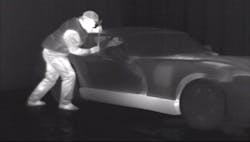The Business Case for Thermal
Thermal security cameras can see as well at night as they can during the day. That is one of the reasons why thermal imaging is becoming increasingly popular as a solution for intrusion detection and perimeter protection. In contrast, cameras dependent on visible light are useless at night or in poor visibility without supplementary illumination from lights or lasers. As most security integrators are aware, thermal imaging cameras produce images of invisible infrared or "heat" radiation.
Regardless of application, there are several considerations to discuss with your customers when investing in a thermal imaging camera.
Price and Cost of Ownership
Although thermal and visible light technologies have their own advantages and disadvantages, thermal imaging can be a cost-effective solution for protecting a perimeter, especially considering it needs to be monitored during the night.
For thermal imaging systems, the initial purchase cost is lower than many traditional video surveillance systems — although a single thermal imaging camera is more expensive than a CCTV camera, fewer cameras will be needed to cover the same extended perimeter. Maintenance costs — power, spare parts, etc. — are also lower in comparison.
From an installation perspective, the civil works that need to be carried out are minimal. In some cases, the cameras can even be mounted on existing structures. Furthermore, since thermal imaging cameras produce a clear image at nights, complementary technologies such as lighting or infrared illuminators are not needed. Not only does this limit the amount of civil works that needs to be carried out, it also reduces the maintenance cost.
The Right Camera for the Application
There is no easy answer to the question “how far can I see with a thermal imaging camera?” It depends on a large number of environmental and system variables, including the nature of the target (parked vehicle vs. running vehicle), the background (hot desert vs. cold snow), and atmospheric conditions (clear skies vs. fog). It also depends on the specific camera and lens combination.
There is a difference between how far your customer can see with a cooled and with an uncooled thermal imaging camera. Extremely long-range thermal imaging applications are best served by cooled camera systems.
Cooled camera systems are more expensive, but generally have a longer range than uncooled systems under many conditions. A typical cooled camera has a 15 micron pixel pitch (spacing between pixel centers). A 500mm lens on this camera gives an IFoV of 30 microradians. Using the 0.75m critical dimension, a man will subtend 12 pixels at a range of 2.1km.
An uncooled sensor has inherently less sensitivity than a cooled sensor with comparable optics and bigger pixels. A typical uncooled sensor has 25 micron pitch. This increased pixel size shortens the 500mm lens identification range to 1.25 km. Most FLIR thermal imaging cameras contain an uncooled Vanadium Oxide detector which requires virtually no maintenance.
Protect the Hardware and the Installer
Especially in outdoor environments, thermal cameras have to endure a lot. Lightning strikes, for example, can cause irreparable damage to outdoor cameras. Often installed in remote locations, outdoor cameras will rely on sometimes poor-quality power. Poor input power quality may be compounded by the injection of noise, voltage spikes and transients onto the power, Ethernet and video coax cables along the long cable runs to each camera.
Make sure the camera selected has been engineered to provide a high degree of protection against a variety of problematic power, communication and video signal conditions that can cause problems for cameras. More specifically, the cameras must meet the requirements of EN55022 Class A, EN61000-3-3 and EN50130-4 standards. The benefits of this added protection include: uninterrupted operation in a wide range of conditions, a high degree of protection against electrical storms and immunity to electrical noise in industrial environments.
The human body is charged, so an installation technician should always be grounded while handling an electronic device, in order to avoid static discharge and subsequent component damage. Look for cameras that use dedicated circuitry protection to fully protect against Electrostatic Discharge (ESD) damage which could be induced by an ungrounded installer. Installers should not need to take special precautions (static wrist straps, etc.) when connecting wiring with all contact points fully protected against static discharge.
Vendor Selection
Different applications require different types of thermal imaging cameras. First-time users have different needs than those that have already discovered the benefits of thermal imaging. Some applications require a wide angle lens; others are better served with a tele-photolens. Be sure your vendor partner can offer a system completely suited for the particular application.
Also, choose a system that can grow with your customer’s needs. As they start to discover the benefits thermal imaging has to offer, their needs will undoubtedly change. Thus, it may be beneficial to partner with a vendor that is able to take the first camera back and offer a more advanced model.
Some vendors offer design tools to enable the integrator to plan and design the entire security application and camera layout before it is installed. This is key to finding any blind-spots on a large perimeter. FLIR Raven, for example, is a free tool that uses Google Maps to help plan system design and layout. It illustrates the area of detection coverage, allowing the integrator to plan which cameras should be installed and where.
Once in operation, a thermal imaging camera rapidly becomes a vital piece of equipment for your customer. Make sure that the manufacturer can service your camera in a short period of time if a problem should occur. A vendor partner should also offer initial or extensive training to the integrator’s staff and your customers.
Wesley Moore ([email protected]) is the Marketing Director of FLIR Security. Request more info about the company by visiting www.securityinfowatch.com/10213696.
